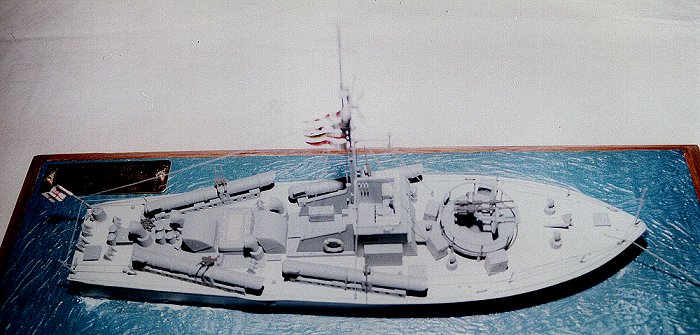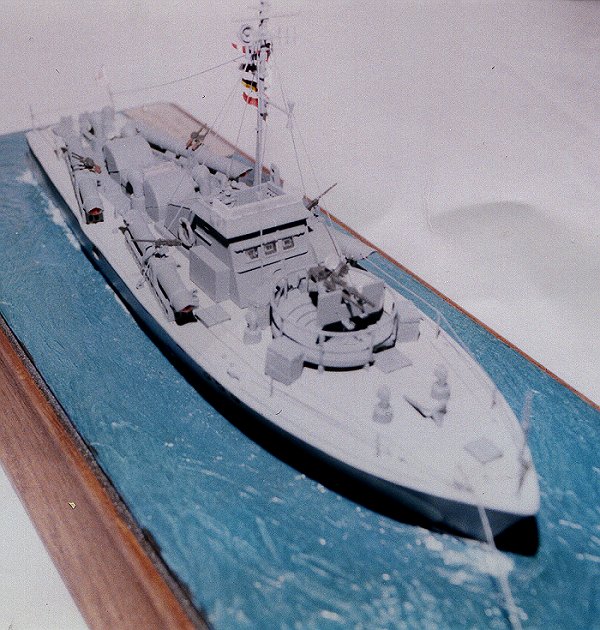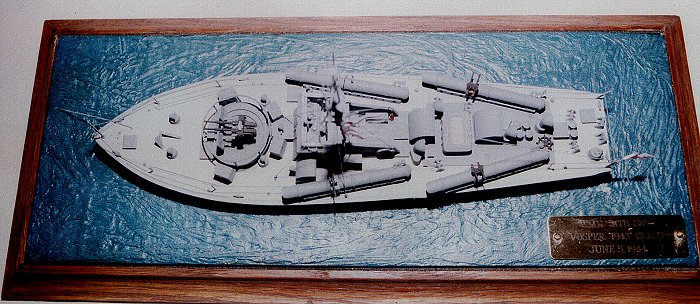
Airfix 1/72 Vosper MTB
|
KIT # |
5280 |
|
PRICE: |
$16.00 |
|
DECALS: |
|
|
REVIEW : |
T.Garth Connelly |
|
NOTES: |
Model built by Stanley A. Pienkowski |
MTB-385 on the Eve of the D-Day Invasion
|
BACKGROUND |

In 1997, under the auspices of doing research for a second In Action series book on British Vosper Motor Torpedo Boats, my older brother went with me to England. My brother went with me because I am physically disabled. I did a considerable amount of research that first trip. I also was able to do some sightseeing as well. On a trip to the Royal Navyís Dockyard in Portsmouth, to see the H.M.S Victory, I saw a sixty-foot Vosper Motor Torpedo Boat that was awaiting restoration.
When I was in High School, in the mid-seventies, my father bought me a model of a British torpedo boat, the 1/72nd scale Airfix kit of the seventy three foot Vosper Motor Torpedo Boat. He even built it for me, but he just painted the bottom black and did not put on any decals. Somehow, the model ended up in our basement and in 1978, when our basement was flooded, that model as well as some of my unbuilt kits, was thrown out.
I never gave any thought of replacing the model because at that time, my father did not have any free time to build models anymore, nor did my brother. As I was writing the text of the book on the Vospers. I thought since I had written a book on American PT boats in 1994, and by 1996, I had several models of three types of PT boats, it might be a good idea to have a model of a British Motor Torpedo Boat.
One day, after we returned from England, my brother was in a local hobby shop with our nephew (who accompanied us on each of our three now four trips to England) and they saw an old Airfix kit of a Vosper seventy three foot MTB on a "dollar table." So, they picked it up for me. By that time, I had met Stan Pienkowski and I knew it would be built and done completely.
The Type
This model depicts a unit of the Vosper Type I. The boats of this type were built from 1943 onward. The type was armed with four eighteen-inch torpedoes, a twin 20mm Oerlikon and optional single .50 caliber machine guns or two single two inch rocket flare projectors mounted on the forward tubes and twin .303 inch Vickers guns mounted on the after tubes. They were powered by three Packard engines that were supercharged, each producing 1,400b.h.p, which gave the boats a maximum speed of 39.9 knots. At a speed of 20 knots, they had an operational range of four hundred seventy miles. All of the Type Is and the follow-on Type IIs were operated in home waters.
The model, which my brother bought for me, was one of the ones from the mid-1970s, like the one my father had gotten me while I was in high school. It even had the same box art. The kit itself has a good, general outline and it does seem to match the pictures that I have seen of that type, but, I am quite sure that a skilled scale modeler would be able to pick out flaws in it.
However, I am somewhat of a contradiction in terms, on the one hand, I love a highly detailed model and I love to see every minute detail put into a model. But, by the same token, if a kit is from the 1960s and 1970s, when model kits were considered to be toy-like, I understand that a manufacturer might not have put in details. That would be, and is quite fine to me. I would consider the era in which it was manufactured before I start discounting a kitís accuracy. Sure, a kit from back then was no way as detailed as the kits of today, but today's technology allows us to have better detailed kits.
Also, remember, today we also have after-market accessories that help us make a kit more detailed. So, even a mediocre kit from the 1960s, like Revellís Fletcher Class Destroyer could be transformed into a good-looking model with a little imagination and work. So, therefore, ergo and towit, if there are flaws in the Airfix Vosper MTB kit, they can be remedied by either scratchbuilding new parts or by using after-market accessories.
|
CONSTRUCTION |

My Vosper was built straight from the box, which, ever since I have become acquainted with Stan Pienkowski, is a rarity. That was because of two reasons. One, Ö because, at that time, I had just gotten to know Stan, and did not want to be an imposition on him. Two, again, at that time, I did not know much about British MTBs. This lack of knowledge would come to haunt me when it became time to paint the model. But, as I have come to know Stan, I have also come to realize that he actually enjoys super-detailing a model perhaps more than I do. Which is fine by me.
The only break from the straight-from-the-box description of this modeling project was the fact that I did not have Stan put the bottom of the hull on. I had decided to have him make it as a waterline model. This was because I have never had a water-line model and they always had intrigued me. This project would therefore be an experiment for me. As it turned out, Mr. Pienkowski proved to be quite adept at creating water. Oh, Ö to be a God, Ö "let there be water, Ö and there wasÖ"
If, at that time, I knew more about Vosper MTBs than I do now, I would have bought (and/or scrounged) better guns than the kitís two single Browning .50 caliber machine guns and the twin 20mm Oerlikon gun. One could also replace the two twin .303 caliber machine guns, though the .303s are really quite good. I know that H-R Products has a twin 20mm Oerlikon, but, I kind of thought that the kitís own 20mm gun was "good enough for government work."
That was because I never really thought about entering this model in a model show. Though, at that time, and even now, I do not know of any after-market accessory manufacturer that makes twin .303 caliber machine guns.
I suppose, in total 20/20 hindsight logic, that I could have scrounged some .50 caliber machine guns from a World War II bomber and I guess that the .303s could come from a kit of a British World War II bomber. But, at the time of the construction of this model, my thoughts were not really on adding more details to the kit. Also, like I have said, it was during an early stage of Stanís and my "partnership" and I did not want to appear too demanding.
The reason behind my wanting this model built was that I want to be like one of my favorite authors, Clive Cussler. I have heard that he has a model built for every ship his underwater archaeological team discovers and works on. I thought I would, therefore, have models built of PT boats, for my book on PT boats, an Vosper MTB for my book on MTBs and if I ever do a book on German S-Boats, Ö then, I will have a model of a S-Boat built. Hey, if Clive Cussler can do it, why canít I?
The Water
Stan created the water by using a piece of Sheetrock, covering it with Spackle to simulate the wave action of the water. He used the now discarded bottom of the hull to stand in as an outline of the boat to form where the boat would be placed. After that, he spray-painted the water with dark blue paint and green paint and dry brushed white paint over that to create wave tops.
The Paint Scheme
The boat was painted as per the instruction sheet because, at that time, I did not know much about MTBs. If I had, I would have caught an error. A rather big and glaring error. The colors of the scheme were reversed. What was supposed to be light gray was instructed to be dark gray and what was supposed to be dark gray was supposed to be painted light gray instead of the other way around. I did not know that! I did not catch that until I was doing the layout for my book on Vosper MTBs two years later. Oh well. I did not feel as bad about it after I had a visit from an English expert on MTBs and he did not notice the error.
|
IN CONCLUSION |
This is a basically good kit. It does lack detail in some places, but a really skilled modeler should be able to fix any inaccuracies without trouble.

T.Garth Connelly
Copyright ModelingMadness.com
If you would like your product reviewed fairly and fairly quickly, pleasecontact the editor or see other details in the Note to Contributors.